Gerard Butler Hunter Killer
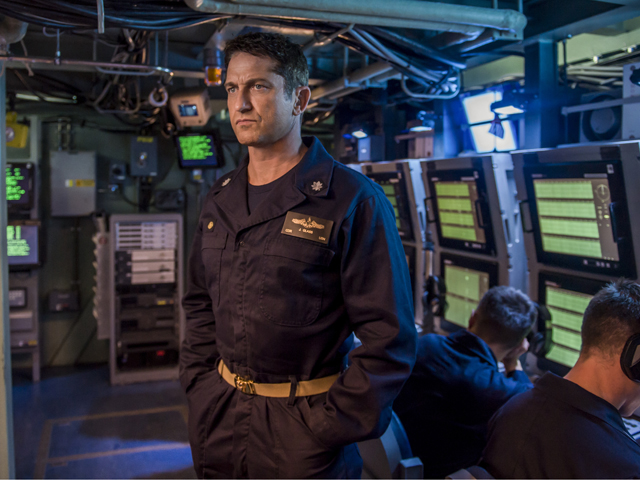
HUNTER KILLER (hən(t)ərˈkilər): a naval vessel, especially a submarine, equipped to locate and destroy enemy vessels, especially other submarines.
Cast: Gary Oldman, Gerard Butler, Common ., Caroline Goodall, Michael Trucco, Michael Nyqvist
Director: Donovan Marsh
Genre: Action, Thriller
Rated: MA15+
Running Time: 121 minutes
Synopsis: Deep under the Arctic Ocean, American submarine Captain Joe Glass (Gerard Butler, Olympus Has Fallen, 300) is on the hunt for a U.S. sub in distress when he discovers a secret Russian coup is in the offing, threatening to dismantle the world order. With crew and country on the line, Captain Glass must now assemble an elite group of Navy SEALs to rescue the kidnapped Russian president and sneak through enemy waters to stop WWIII.
Hunter Killer
Release Date: October 25th, 2018
About The Production
Deep beneath the icy surface of the Arctic Circle, the Cold War never really ended. Here, at extreme depths invisible to the world, U.S. and Russian submarines continue to play ultra-high-stakes rounds of hide-andseek through harrowingly narrow passages, as a constant reminder to one another of the unthinkable costs of sudden aggression. Peril has only mounted amid heightened tensions as a new generation of highly sophisticated nuclear attack subs prowl the murky depths, persistently trailing and shadowing one another as if a full-blown battle is about to break out.
But what if these charged war games suddenly stopped being a game at all? What if, as chaos erupts on land, there is only one shot to pull the world back from the brink of WWIII and unthinkable nuclear conflict?
This is the relentlessly tense situation audiences are plunged into in Hunter Killer, aptly named for the sleek attack subs created to boldly approach the enemy without detection.
It all begins as a Russian sub sinks in the Arctic Ocean. Soon after, the U.S. sub ghosting it also mysteriously vanishes. In the midst of investigating these unsettling events, military brass in Washington D.C. are sent scrambling when they discover a rogue Russian admiral is attempting to carry out a bloodthirsty coup at a naval base in Russia. The only hope to halt a war of the superpowers lies in the efforts of two secret crews.
First, a clandestine Black Ops team of ex-SEALs must try to sneak into Russian territory to intercept the kidnapping of the Russian President. Simultaneously, in the sea, Captain Joe Glass and the young crew of the USS Arkansas are under orders to head towards the enemy. As a hunter-killer captain, Glass has mastered the rules of the cat-and-mouse game but will now have to courageously break them, as he realizes that this time the cat and the mouse may have to join forces.
The film takes the classic submarine thriller"with all its nail-biting tension, claustrophobia, physical and psychological pressure"into the post-Cold War era when flash coups and counter-reactions can alter the balance of world power overnight. As the steely Captain Glass comes face-to-face with his stoic Russian counterpart, Captain Andropov (Michael Nyqvist), it becomes clear that the wary, distrustful bond between them may be all that stands between the world and nuclear catastrophe.
Featuring an all-star cast led by Gerard Butler, Gary Oldman and Common, the film's action moves from deep sea to land and back again. But most of all, Hunter Killer, authentically captures the 21st Century world of the so-called "silent service," the men and women who serve by patrolling the deep, while their boldest exploits often go unheard and unseen.
Says Butler: "When I first read this script a few years ago, I loved it immediately. It's a classic story with a heck of a lot of great action, a heck of an intricate plot and a whole cast of fantastic characters who are heroes from different walks of life. It felt like an exciting way to revive the submarine thriller for these times. And right now, this story couldn't feel more relevant."
Summarizes director Donovan Marsh, "Hunter Killer is about a fictional event"but it could easily occur in today's world. There have been many recent news articles about how Russian and American submarines are chasing each other under water in dangerous ways. Yet, because it's happening under the ocean, the public never knows what's going on. That's how our movie begins: with two submarines ghosting each other through the ocean … resulting in an incident that quickly escalates to the brink of war. I think audiences will be thrilled, they'll be moved and they'll have a good deal of fun, all while watching a story highly significant to what's happening in 2018."
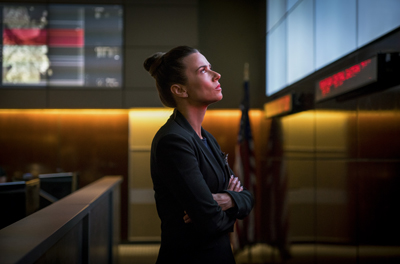 Initial Descent
Initial Descent
The authenticity of Hunter Killer started with its source material: the novel "Firing Point," written by George Wallace, the highly experienced, retired commander of the nuclear attack submarine the USS Houston, along with the award-winning journalist and best-selling author Don Keith. The book's action-packed plot, based on Wallace's extensive knowledge, twisted and turned through a Russian nationalist coup, a Black Ops Navy SEAL mission and an attack submarine captain faced with decisions that could halt"or instantly ignite" WWIII. Complex as it was, the story was so teeth-grittingly plausible it kept readers up late at night.
Even more than the thrills, readers were transported into life on a nuclear sub, immersed into the cramped, sundeprived, nerve-shredding ambience where steadiness and honor are the only bedrock to be found. The cinematic appeal of the book was so strong that chatter about a film adaption began. For more than a century, filmmakers have been drawn to the deepest deep. Indeed, the submarine movie has been a popular genre since the earliest days of commercial motion pictures. From the silent Secret of the Submarine in 1915 to a flood of nerve-wracking WWII sub movies to the groundbreakingly visceral German film Das Boot to the blockbuster adaptations of Tom Clancy's The Hunt For Red October and Crimson Tide in the 1990s, the tightlycontained space inside a sub full of soldiers facing extremes of confinement, anxiety and danger has been rife with the stuff of drama. But in the wake of vast changes in submarine technology"and in the world"in the new millennium, no film had yet submersed itself into life on a 21st Century naval submarine.
This changed when screenwriters Arne L. Schmidt and Jamie Moss adapted "Firing Point" into Hunter Killer.
Compressing the 700-plus-page novel into a taut exploration of the battle to stop a war both on land and below the water.
Comments producer Toby Jaffe, "I love any movie that transports you into a world you don't really know" and Hunter Killer really does that. We approached it as both a highly entertaining dramatic thriller and an opportunity to take the audience into the world of submarine culture in a way that is authentic and contemporary to our times. Our focus from the start was on making the film as true to life, timely and ofthe-moment as we could."
Early on, action icon Gerard Butler eyed the unusual role of Captain Joe Glass"who is more about daring strategy than physical derring-do"which further boosted the development. "What's fascinating about Glass to me is that he has to make decisions that will affect the world for hundreds of years because we're talking about the immediate possibility of sparking an all-out World War III. So he's up against the highest stakes imaginable," says Butler, "and the way things unfold for him is both really suspenseful and surprisingly believable in today's geopolitical circumstances."
Everyone involved was drawn to the exhilarating idea of merging what would usually be three different kinds of thrillers"an edge-of-your-seat submarine thriller; a hazard-filled SEALs expedition into enemy territory; and a clashing of the minds in a military War Room"into one portrait of a world hurtling towards war.
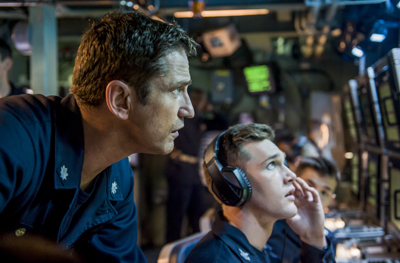 Taking Command
Taking Command
To make that mix come alive on the screen in a very 2018 way, the producers went in search of a young director with a fresh POV. They found what they were looking for in an unlikely place: South Africa, where Donovan Marsh had just come to the fore with his stylish, award-winning crime drama iNumber, Number.
"We were very excited to find a young filmmaker who was ready and excited to bring a different sensibility to the submarine thriller," says Jaffe.
Marsh's furiously paced, hyperkinetic style seemed to lend itself to breaking open the closed-in spaces of a submarine.
As hoped for, the script grabbed Marsh's attention and sparked a driving passion. "I felt it was the best military thriller I'd ever read," he recalls. "The essence of any great thriller is that you can't predict what's going to happen next, and as I read this script, I was genuinely on edge all the way. Plus it had such great, tough characters facing huge dilemmas that are too real."
In line with the producers, Marsh immediately envisioned going to whatever lengths he could to create an authentically 21st Century submarine immersion for audiences. "I wanted the interior of our submarine to look precisely like a real nuclear submarine. I wanted everything on our sets to be so real that a submariner wouldn't know the difference," explains Marsh. "And I wanted people to talk in the way they talk aboard submarines"because even though the audience might now know exactly what that terminology is, they know when the dialogue and atmosphere has that crack of realness."
The filmmakers all knew that the authenticity could only really be set in motion with the support and involvement of the U.S. Navy and Department of Defense. Driven by deep respect for the real men and women who defend the oceans in near invisibility, the filmmakers secured an early agreement to partner with the U.S. Navy in nearly every aspect of the production. "Early on, we approached the Department of Defense and the Navy to ask for their help," explains Jaffe. "We were very grateful to be given so much, including the chance to spend time on working submarines and to have Navy technical advisors on set at all times assuring we could recreate the latest submarines down to the knobs and dials and get all the little details right, down to the lingo and commands."
Before production even began, Marsh and Butler headed to Pearl Harbor where they embarked out to sea with the crew of a Virginia Class nuclear sub very similar to the USS Arkansas for three eye-opening days. The trip would have a profound impact on the both the filmmaking and the lead performance. "Gerry and I were actually able to re-enact scenes from the film in the sub with a real Naval crew. That was so invaluable for both of us," says Marsh. "When we were back on dry land and on set, we were able to bring all that intense realness we experienced to the execution."
This journey also led to one of Marsh's most essential, if seriously challenging, ideas: to place the film's entire submarine set on a massive hydraulic gimbal to forge realistic movement. "You realize when you are on a submarine and you get down to 50 degrees, everything starts leaning and everything that isn't nailed down just goes flying," elaborates Marsh. "It was quite a thrilling feeling to experience and I wanted the actors to be able to have that as much as you possibly can on dry land. It's traditionally been done by tilting the camera but that just wasn't real enough. Mounting the set on a gimbal wasn't easy but everyone loved it. It created a very spontaneous tension and gave everyone the feeling of being at sea."
In another coup, the Navy opened up a working nuclear submarine docked at Pearl Harbor to cinematography for two days"working closely with Marsh to ensure no classified secrets could leak out. "We had one day to shoot the interior so that we could cut a few shots seamlessly with our set. And then on day two, we took the submarine out to sea so we could film it out in the water. There was no way I felt that CGI could do justice to a submarine on the surface of the water," says Marsh. "Having seen it up close, I knew that it would be amazing to get that shot. This incredible 8,000-ton piece of machinery has a certain interaction with the water you cannot replicate any other way. There were huge challenges involved in all of this, but we wanted to create an amazing experience for the audience and we had the chance to do it."
For the film's U.S. Navy consultant Russell Coons it was especially important that the USS Arkansas looked as diverse and dynamic as the U.S. Navy does today. "We wanted to make sure you see women in key positions," he notes. "The result is exciting because this film marks the first chance for Navy women to see themselves at sea in a movie."
To up the training, Coons took the cast and crew into a damage control trainer, which simulates a variety of battle emergencies, from flooding to fire. "It was exciting for them," he recalls. "We got them wet while they had to figure out how to fight and fix the ship. And we also introduced the cast to many real Navy crew members so they could get a sense of how Navy personnel talk, the language, the culture and especially the bonds of camaraderie between them."
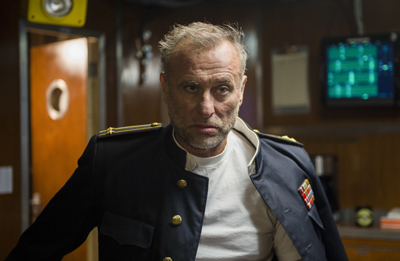 Captain Joe Glass of the USS Arkansas
Captain Joe Glass of the USS Arkansas
Gerard Butler is no stranger to portraying badass men of action. From the Spartan ruler Leonidias in the epic 300 to Secret Service agent Mike Banning in Olympus Has Fallen to no-nonsense Los Angeles Sheriff Big Nick O'Brien in Den of Thieves, Butler's intense physicality has often been on display. But for Donovan Marsh, Butler reveals a very different side to heroism as the fiercely intelligent and quietly bold Captain Joe Glass in Hunter Killer. "He's still the action guy who makes it all happen, but he does it from a position of authority rather than being the guy out there pulling the trigger," Marsh explains. "It required Gerry to contain his performance in a different way, which he did absolutely beautifully. He invested himself so strongly, that you would regularly see 20 or 30 actors on set responding to him like a real commander. You believed him that much." Glass knows that trust is the only sinew that can hold together a young and anxious submarine crew with so little contact with the outside world. But he has to forge that trust on his boat one savvy move at a time. "At first nobody quite trusts Glass because he seems a little nuts," notes Butler. "But you see him carefully build his bond with the crew as they begin to realize how serious their mission is. They start out as young men and women who are mostly playing at their roles and then you get to watch as they become incredibly honed warriors daring to attempt the impossible."
The trust issues get far more complicated when the USS Arkansas takes aboard a group of rescued Russians who, though ostensibly the enemy, may actually be the key to everyone's survival. For Butler, that's when things get really interesting, as Glass faces off with a man who is essentially his alter-ego, Captain Andropov, played by the late Swedish actor Michael Nyqvist.
"I see this movie in some ways as a love story of friendship and respect between these two captains from opposite sides of the world and opposite cultures," Butler says. "They're enemies. But as individuals, they each have the ability to do things differently than anybody else would"they both can see above and beyond the normal rules of conflict and engagement. Andropov is an old salty dog of a warrior while Glass is a hardnosed, blue-collar Navy man. Yet they both have respect for the other and their almost silent relationship drives the outcome of the story."
To prepare to play Glass, Butler not only took that initial trip out on a working nuclear sub, he also spent extensive time with a number of former U.S. Navy commanders to channel their inner cores. "The advisers I consulted with were indispensable," he says. "These are people who drill and drill and drill so that when things hit the fan, they can make the right moves, like it's in their sleep. Everything has to be automatic because when you've got freezing cold water coming in, the carbon dioxide is building, there's a fire going on, the place is full of smoke and you know your sub is about to go down, you need to be able to act in half a second. Learning about that was very, very enlightening. You see that it takes certain kind of individual to be able to lead in this very hazardous narrow tube."
Naval advisor Captain Russell Coons was thrilled to see how intently Butler devoted himself to understanding the submariner's mindset. "He was like a kid in a candy store excited to take in as much information as he could learn," describes Coons. "We really appreciated him going out to sea on our submarine and seeing how we act as a team, and I think he was really excited to discover how talented and smart the people who work on submarines are. He was very impressed."
Co-author and veteran sub commander George Wallace notes that someone like Glass, no matter how much of an iconoclast and independent thinker, would have an extraordinary breadth of knowledge. "You can think of commanding a sub as like driving an 8,000-ton sports car. It's fun but it's also incredibly complex. You have to know and deeply understand every system involved." Butler took that all in, as well as exploring the psychological stresses weighing on a commander like Glass.
"I was very interested in the way that Naval Captains think and the pressures that play on them," Butler says. "I talked a lot with Donovan about the idea that submarine crews face not just death but the lonely prospect of sinking to the bottom of the dark sea. That's something that they have to live with all the time"and that knowledge builds their character and also the incredible camaraderie you see on submarines. There's something about knowing that on a sub, no matter what happens, no matter if you're the Captain or a junior officer, you're all in this together."
Working with military consultants also keyed Butler into the often sharp, tangy and slang-filled language spoken among submarine crew. "At first, I would hear Navy guys talk without understanding them but by working alongside the consultants and constantly interacting with the guys, I became familiar with their terminology," Butler explains.
"We found fun ways to incorporate some of the language in the film because it makes things that much more believable. In a real emergency situation, when you have everybody calling out commands in the proper form, it's incredible to witness how intense it gets, even if you don't completely understand their slang. The whole ship is chanting and moving together in this beautiful flow of energy. It's a very powerful experience. We wanted to capture that and when we'd finish those scenes, everybody would have goose bumps."
Producer Toby Jaffe was exhilarated to see Butler transform into a commander capable of uniting his crew when it most counts. "Gerry was a great partner on Hunter Killer from the very beginning. Every step of the way, he helped to push the script forward and he was there advocating to make the final movie more and more authentic and compelling."
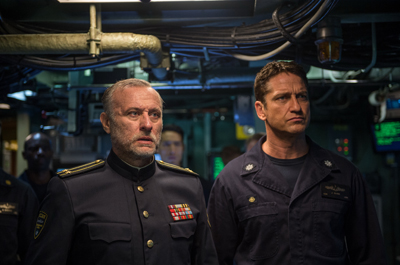 Captain Andropov
Captain Andropov
When the USS Arkansas rescues the surviving Russian crew aboard a crippled sub, Captain Glass comes faceto-face with a man who under other circumstances might be his most feared enemy, but who reflects a mirror image of himself. This is Captain Andropov"and both men will come to take enormous risks as they wrestle with how much to trust the other.
Playing off Gerard Butler in the role is the late Michael Nyqvist, long considered one of Sweden's most acclaimed actors. Nyqvist, perhaps best known for playing the investigative journalist Michael Blomkvist in the Swedish version of Girl With The Dragon Tattoo, as well as roles in John Wick and Mission Impossible: Ghost Protocol, passed away at age 56 after battling lung cancer.
The chance to work so closely with Nyqvist was a highlight for Butler. "I got so much from his spirit of experimentation, his playfulness and how much he could give you in a single moment. He had this childlike willingness to just try anything and be so brave, and I saw the young cast playing our submarine crew be so inspired by him. I always felt the strongest part of the story was the connection between these two souls, these kindred spirits, and we had that kind of relationship," says Butler.
Donovan Marsh was also moved by Nyqvist's performance. "Michael brought so much heart to the film and in a way his character is the core of everything. The scenes between Michael and Gerry to me are some of the most beautiful in the film."
Nyqvist was absolutely elated to play a submarine captain. "One of my favorite films, and I may have seen it 10 times or more, is the German submarine film Das Boot," he said in an interview on set, "and the reason I liked it so much is for that ingredient of claustrophobia. I actually hate to be claustrophobic myself, so to have the opportunity to play with it, I found intriguing."
There were also portions of Andropov to which Nyqvist strongly related. "The craft of being a sailor for me is interesting because nearly everyone in Sweden learns to sail as a child. That's one part of Andropov I really understand. The other thing is that he is a patriot in an Old School way. What happens to him is a betrayal by his own country and he finds it unbelievable and that is very relatable. That is what I, as an actor, always go for."
Nyqvist, too, said he felt inspired by the rapport with Butler. "As an actor, you feel instantly if someone trusts you or not and Gerry did trust me which meant that I had a lot of freedom. Glass and Andropov trust each other as sailors and at the end of the day, these two captains find they are in the same situation. They have to help each other and that becomes a key theme of the story: trust."
For Nyqvist, that theme had a lot of resonance. "We live in a time now in which a lot of people are afraid" but maybe we can trust more and we can talk to each other more. If you don't believe in your prejudice and your fears, we might have a better world," he said.
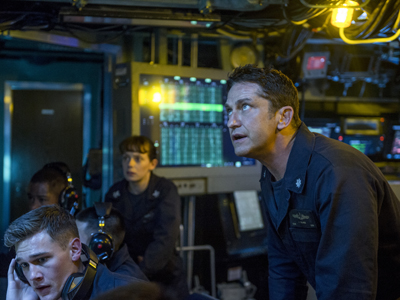 On Land: Chiefs In The War Room And Black Ops In The Field
On Land: Chiefs In The War Room And Black Ops In The Field
While Captain Glass wrestles with the right moves in the deep blue, the military brass in Washington D.C. race to figure out the best response to the imminent global crisis for the United States. The man leading the charge towards military action in the War Room is the resolute Admiral Charles Donnegan, Chairman of the Joint Chiefs of Staff"and taking the role is Gary Oldman, fresh off an Oscar® win for his nearly supernatural embodiment of a very different leader, portraying Winston Churchill in Darkest Hour.
"Gary is a legend and it was a dream come true to work with a man who is literally one of my film idols. He brought so much gravitas to the role of Donnegan," says Marsh.
Oldman was intrigued by playing a man who must face split-second decisions where there is zero margin for error"and who steadfastly believes it's his duty to respond to fire with fire, no matter the consequences.
"This rogue Russian Admiral has a master plan. He thinks that, sort of like a magician's sleight of hand, that while the U.S. is preoccupied with preventing a nuclear war, he'll pull off his coup without resistance," Oldman describes. "But Donnegan feels his job is to respond to any threat with strength and intent."
Oldman especially enjoyed working closely with the military experts who were present on set each day. "For this kind of movie with so many technical elements it was an absolute necessity to have experts on military protocol. It was just invaluable for all of us," he says.
Opposing Donnegan in the War Room with a more cautious POV is Rear Admiral John Fisk who oversees Naval operations. The filmmakers went in a fresh direction with Fisk, casting Common, the Oscar®-winning songwriter, rapper, poet and film producer who has also been building an exciting and eclectic screen career with roles in Selma, Wanted, John Wick: Chapter 2 and The Tale, among others.
He was a revelation on set. Says Marsh, "I personally knew Common more from his music but it was quickly clear that he has so much innate talent as an actor and he came at this role with a great attitude and a very open mind. We had a wonderful collaboration."
Long fascinated by submarines, Common was elated to play a man steeped in his love for the Navy. "The Navy is the first line of defense when it comes to war or any threat to national security," Common points out. "So my character, Fisk, has to make decisions that are complex and have huge consequences in the world. He knows that the information he provides to his Commander-in-Chief can start or stop a war and he has to take every moment of his job very, very seriously."
Captain Russell Coons, the Navy consultant, points out that a man like Fisk would have a vast amount of experience to bring to the table and his decisions. "As a two-star Admiral, Fisk would have needed 25 to 30 years to attain that rank," Coons explains. "He likely would have had four or five tours overseas, each time being gone for six to nine months. He would have had to leave his family to go into war zones. So all of that had to be resident in how Common portrays Fisk."
Common did all he could to immerse himself in that mindset and, in the process, he says he gained an even deeper respect for members of the military. "I learned a lot more about what people in the Navy really go through. I came to really appreciate the mentality that there are no individuals, everybody is in it together. And I think that idea lies at the core of Fisk and what he believes."
Fisk also has to counter his boss, Donnegan. "Donnegan is quick to believe that World War III is already in motion," explains Common. "He has a certain way of thinking about conflict that I think Fisk sees as rooted in the past. Fisk is from a generation that is more open-minded and about seeking peace. So they represent opposite strategies at the Pentagon."
That real-life conflict is part of what Common most loves about Hunter Killer. "As much as it is a piece of fun entertainment with a lot of action and suspense, I like that the story speaks to the issues and themes we are dealing with today," he says.
Ultimately, Fisk joins forces with senior National Security Agency analyst Jayne Norquist in a last-ditch bid to avoid all-out war. "Fisk and Norquist share a way of thinking that's about trying to strategize past a shooting war," Common explains.
To play the savvy Norquist, the filmmakers cast Linda Cardellini, who got her start on television's Freaks and Geeks and has rapidly risen with roles in the acclaimed Mad Men series, as Laura Barton in Avengers: Age of Ultron and in this year's A Simple Favor opposite Anna Kendrick and Blake Lively.
Cardellini could not resist the opportunity to play a woman who is among the most skilled minds in Washington. "This is very different from anything else I've ever done," she says, "and the idea of being a player in the War Room was exciting. I love that Norquist is also a working mom, a woman who splits her time between the standard worries of the world and keeping some of the world's most dangerous secrets.
It's very subtle but it's there and I think it informs the decisions that she makes."
Rounding out the main cast on land is the hard-bitten, sharp-tongued quartet of Navy SEALs tasked with going underground in Russia to try to the rescue the legitimate Russian President from his own military. Taking the roles are Toby Stephens (Die Another Day, 13 Hours, Lost In Space), Michael Trucco (Hush), Zane Holtz (From Dusk Till Dawn) and Ryan McPartlin (J. Edgar).
Says Gerard Butler, "I love the Navy SEALs in Hunter Killer. They bring great action to the movie, as well as humor, fun and badassery, the kind of stuff I normally do, and they did a great job."
Stephens plays the leader of the Black Ops team, the sarcastic but no-less-devoted Lt. Bill Beaman. He saw the role as a fun opportunity to dive headlong into the world of elite commandos and relished the boot camp training. "I did a lot of research on the SEALs, what kind of training they do and what they are expected to do in the field. But research is one thing," he points out. "When you actually experience it, even at a minor level like we did, you really can't believe what they go through and how tough they must be. When you have a full pack on, a full weighted gun and all the equipment, simply running 100 meters is exhausting, let alone running on rough terrain while evading gunfire. What they do every day is just incredible to contemplate."
The training, if not quite at the level of real Navy SEALs, paid off. "When you work with real Special Forces and military guys, you don't want to be the one that lets them down. You know you can never be as smooth and efficient as these guys who have been doing it for years but you want to at least be good enough to pay homage to their abilities," he says.
While throwing himself into Beaman's very specific world of covert operations, Stephens notes that it was easy to forget how many strands are woven into Hunter Killer's taut structure. "What I think audiences will find really cool about Hunter Killer is that you have these really contrasting spheres of action. You have all the claustrophobia and contained anxiety of being on the sub and then you have our Black Ops team operating amid gunfire in these big, wide-open spaces. That combination keeps things really interesting." Les Weldon notes that Stephens provides a counterpoint to Captain Glass, who operates so effectively in a confined space, as a man who cannot be contained by walls or even armed militias. "Toby just has this wonderful grit about him. He keyed into Beaman's witty, sardonic take on the dangers of his life and gave him a real edge," says Weldon. "At the same time, Toby has an ability to connect on a human level, despite being this very hardened character. I think audiences are going to be very surprised by his performance."
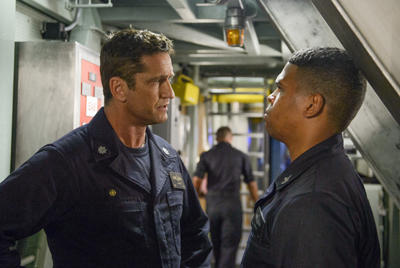 Diving Deeper
Diving Deeper
With action unfolding in three disparate realms"a hunter-killer sub roaming the ocean's bottom at the top of the world; a Black Ops operation at a Russian base; and the urgent response inside the halls of the Pentagon" Hunter Killer called for essentially designing three films in one. To accomplish this, Donovan Marsh worked with an inventive crew that included South African director of photography Tom Marais (Avenged), production designer Jon Henson (Criminal), and costume designer Caroline Harris (Legend, 42, A Knight's Tale).
Two of the film's most intricate sets were built at London's Ealing Studios, the oldest continuously working studio facility for film production in the world. It was here that, under the aegis of Henson, the crew painstakingly recreated the inner workings of a Virginia Class submarine, the advanced, multi-mission nuclearpowered attack sub that has become renowned for its versatility and agility, on a massive moving gimbal.
The Virginia Class subs"first introduced in the 1990s"are today outfitted with the latest in stealth technology, intelligence gathering equipment and weapons systems, and are so effective they will continue to be a staple of the U.S. Navy fleet until at least 2043.
After riding on a Virginia Class sub with Butler in Pearl Harbor, Marsh knew he wanted the set to reveal to audiences some of what he learned on that trip that took him aback. "What was interesting to me is that sub was not at all how imagined it"and maybe submarine movies are to blame for that," he muses. "So often, the inside of a sub looks like a Corvette, where everything is chrome and spotless. But a real working submarine is not made for beauty. It's a practical war machine. The Navy spares no expense in terms of the technology, but they don't care about how beautiful it looks. In fact, a real submarine looks and feels quite industrial. There are wires and pipes and things just nailed to the wall wherever you look. So that is what I wanted to capture, because it has a certain energy and power to it. And it's quite surprising as well."
Using Navy-approved photographs from the classified sub and 3D printing technology, the design team was able to forge a facsimile that felt real enough to inspire camaraderie and courage. "We all got really excited by the set, and especially by having the chance to show off a submarine that has never been seen by the public or at the movies before," says John Thompson.
Thompson continues, "In our agreement with the US Navy we actually pledged that everything about the sub would be authentic. They were gracious enough to let us reveal this submarine for the first time ever, so Jon Henson spent a couple of weeks with Navy designers and engineers and came back with the most extraordinary details, right down to the color of the cables. The US Navy also provided someone to guide and aid Jon and his team through the build. We wanted it to be so accurate that if someone who'd served on a real Virginia Class sub came to the set, they would recognise it immediately."
Indeed, when former sub commander George Wallace stopped by the set, he was stunned. "The set truly had me feeling like I was on a Virginia," he says. "Of all the submarine movies I've seen, this is by far the most realistic set I've ever encountered."
While the set had to be wider than an actual submarine to allow for Marsh's love of camera movement, it was tight enough to give a sense of the claustrophobia and lack of escape that the men and women who man submarines must cope with daily. Adding to that realism was the yawing motion of the gimbal, which could literally turn everyone upside down when activated. The whole thing awed Butler. "I couldn't believe what they created," he says. "The sub we were on in Pearl Harbor was recreated so beautifully, just a tiny bit wider to allow the cameras through. It had all the same periscopes, sonar screens, navigation charts and controls. I truly felt like I was there."
The exterior of the USS Arkansas was built in Pinewood studios' famed paddock tank, where many famous movie water sequences have been shot. This is where Captain Glass and his crew are seen readying the vessel for their mission into Russian waters. It is also where the Russian Zodiac is pulled up alongside the Arkansas and Glass meets his unseen Black Ops partner Beaman for the first time. (The underwater scenes in which Beaman attempts to rescue the Russian President were shot in one of Leavesdon Film Studios' giant water tanks.)
Meanwhile, on another stage at Ealing, Gary Oldman, Linda Cardellini and Common were tracking events in a carefully re-created War Room from the National Military Command Center at the Pentagon. Much of the action in Russia was shot in Bulgaria. Standing in for the Russian Naval base at Polyarny"the closed city in the extreme northwest of the country where the rogue Admiral Durov takes his own President hostage"was an actual Bulgarian Navy base in Varna, on the Black Sea Coast. The interior of the imposing command center at Polyarny was built at Nu Boyana Film Studios in Sofia, as were the interiors of Captain Andropov's Russian submarine and the sonar room of the USS Arkansas.
With such amazing sets and locations to work with, cinematographer Marais collaborated closely with Butler to maneuver nimbly through both insanely narrow and perilously exposed spaces, keeping the focus on constant flow and constructing unbearable suspense. Says Butler of the photography, "I just love how kinetic everything is, and how much energy Donovan and Tom gave the tensest moments. They brought so much imagination to it."
Meanwhile, military advisors worked not only with the production designers but also with the entire crew to ensure accuracy in everything from uniforms to submarine bunks. Says Coons, "We assisted with props and wardrobe as well as laying out scenes to align with how the Department of Defense would actually do things. There was a lot of give and take and some trade-offs, but in the end, we had a chance to show the military in action very close to the way things would really be."
The authenticity that had been so important to Butler, Marsh and all the producers from the very start seemed to infuse the set, which in turn, served as a constant inspiration to cast, crew and consultants. Muses Coons, "I had subject matter experts on the set tell me they felt like they were actually out at sea on some days. So I hope that audiences will also really feel that. Hunter Killer is chance for audiences to experience a lot of realistic military action but you also will get a chance to see another core part of Navy life"honor, courage and commitment being demonstrated against all odds."
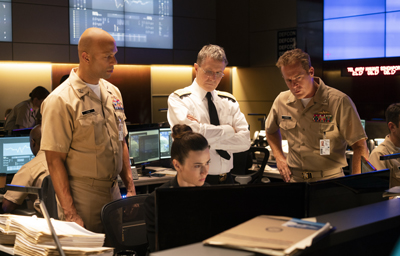 Submariner's Slang Glossary
Submariner's Slang Glossary
ANGLES AND DANGLES: The period of time when a submarine is making major depth changes.
BAFFLES: The blind spot behind a sub where enemies can hide
BAGGED: Getting left with the job someone else was supposed to do
BLUE NOSE: A Sailor who has crossed either the Arctic or Antarctic Circle.
BUNKIE: A term of endearment for a bed or "rack" in Navy parlance
CADILLAC: A mop bucket
CHASING THE BUBBLE: Trying to get the ship to a level angle
CLEAN SWEEP: A successful mission
COUNTDOWN CALENDER: Calendar used to mark the days left to port
CRAZY IVAN: A 180-degree turn to spook a submarine following you
FISH: Torpedoes
GOAT LOCKER: A term of endearment for the Captain's Quarters
JOE NAVY: Term for a Navy lifer
MIDNIGHT COWBOY: The officer given the midnight watch
MOUSE HOUSE: The area occupied by Missile Technicians
PING JOCKEYS: Sonar technicians
RACKING OUT: Going to bed
RAIN LOCKER: Shower stall
RUN, JUMP AND PUKE: The Navy's physical readiness test
SCUTTLEBUTT: A drinking fountain or a rumor (because of the rumors often shared around fountains)
SEA DADDY: An experienced crewmember
SKIMMER: A derogatory term for surface warships
TDU IT: Throw something away (short for Trash Disposal Unit)
ZOOMIES: Radiation
ZULU 5 OSCAR: An intruder or unauthorized person attempting to board
Hunter Killer
Release Date: October 25th, 2018
MORE





